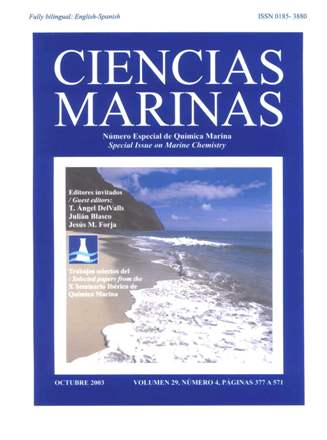Mercury in sediments and pore waters at a contaminated site in the Tagus estuary
Main Article Content
Abstract
Two sediment cores were collected at a contaminated site of the North Channel in the Tagus estuary. Sediments were sliced in 1 to 2-cm vertical sections. Major and minor elements, total organic carbon, total mercury (HNO3 digest), acid volatile sulphides –AVS– (1M HCl and 3M HCl) and simultaneously extractable iron, manganese and mercury were determined in the solids. Labile and total mercury (after UV irradiation) were measured in pore waters. Total mercury concentrations in the first 25 cm of sediment were around 100 nmol g–1, reflecting mainly anthropogenic discharges. A slightly compacted sediment layer (< 1 cm thickness) containing lower Hg concentrations (5 nmol g–1) capped the contaminated sediment. Mercury extracted with 1M HCl was only detected in this layer where AVS are low. In the sediment column, AVS were higher (50 to 197 µmol g–1), labile mercury was detected in pore waters down to 3.5-cm depth, and total dissolved Hg showed a broad maximum at 6 cm of depth (1.1 nM). The co-existence of high AVS and high total dissolved mercury implies the presence of ligands in pore waters with high affinity to mercury, which competes with sulphides and retains the metal in solution.
Downloads
Article Details
This is an open access article distributed under a Creative Commons Attribution 4.0 License, which allows you to share and adapt the work, as long as you give appropriate credit to the original author(s) and the source, provide a link to the Creative Commons license, and indicate if changes were made. Figures, tables and other elements in the article are included in the article’s CC BY 4.0 license, unless otherwise indicated. The journal title is protected by copyrights and not subject to this license. Full license deed can be viewed here.

